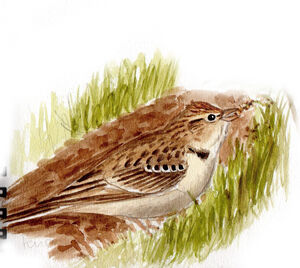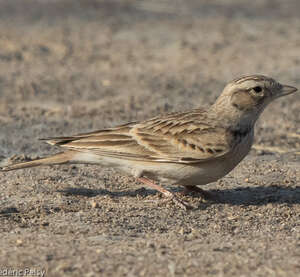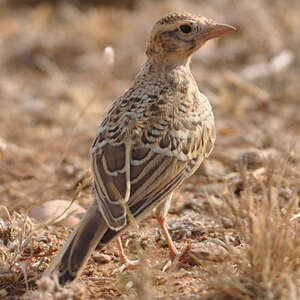Greater Short-toed Lark
Calandrella brachydactyla - Alouette calandrelle
Identification
This species has many geographics and individual variations among the different populations. Approximately the size of a sparrow, it is the smallest lark from Europe. The upperparts of the adult in the nominate subspecies are sandy in color, with dark brown streaks on the mantle and barring of the same color on the coverts. The remiges are brown, while the tertials almost cover the primaries, distinguishing it from the Calandrella rufescens or Greater Short-toed Lark. The crown is grayish-brown and distinctly striated, and it lacks a crest but the crown feathers may be swollen when excited. The dark eyes as if wearing large pale frames (ringed with rusty white and wide eyebrows of the same color). A dark spot marks the lore and the beige parotids are bordered by brown behind. The pinkish or yellowish bill is rather long, conical, with a slightly convex culmen and grayish.
The underside is very pale and uniform. On the base of the neck of each side, there is usually a blackish spot. In some individuals, the spot is indiscernible or only small streaks appear only on the sides of the upper chest, distinguishing it from the Greater Short-toed Lark, which has chest completely striped.
The juvenile is easily distinguished by its scaly upperparts, and there may be some streaks on its chest. Some individuals from the Spanish and North African populations are more reddish-looking with finer stripes.
Subspecific information 8 subspecies
- Calandrella brachydactyla brachydactyla (s Europe and Mediterranean islands, nw Africa?)
- Calandrella brachydactyla hungarica (Hungary and n Serbia)
- Calandrella brachydactyla rubiginosa (n Africa)
- Calandrella brachydactyla hermonensis (s Turkey and Syria to ne Egypt)
- Calandrella brachydactyla woltersi (s Turkey and nw Syria)
- Calandrella brachydactyla artemisiana (c Turkey and Transcaucasia to nw Iran)
- Calandrella brachydactyla longipennis (Ukraine and s Russia to sc Siberia and s Mongolia)
- Calandrella brachydactyla orientalis (c Siberia, n Mongolia and n China)
Foreign names
- Alouette calandrelle,
- Terrera común,
- calhandrinha-galucha,
- Kurzzehenlerche,
- szikipacsirta,
- Kortteenleeuwerik,
- Calandrella,
- korttålärka,
- Dverglerke,
- škovránka krátkoprstá,
- skřivánek krátkoprstý,
- Korttået Lærke,
- lyhytvarvaskiuru,
- terrerola comuna,
- Sandlævirki,
- skowrończyk krótkopalcowy,
- īspirkstu cīrulis,
- kratkoprsti škrjanček,
- Малый жаворонок,
- ニシヒメコウテンシ,
- 大短趾百灵,
- korttålärka,
- 大短趾百靈,
Voice song and call
The Greater Short-toed Lark has a long, monotonous aerial song. It sings mostly at a great height, releasing successive phrases of 7 to 8 high-pitched notes tsisisivoui-tsivoui-thiou, interspersed with cries. The singing is emitted at the end of the descent and during the climb. The cry is a kind of rolled and peeping tchi-tchrrip.
Habitat
The Greater Short-toed Lark is a typically steppe bird. It prefers dry, sandy or stony habitats with low vegetation. It can be found in sunny, sheltered places that feature open ground such as dunes, sand plains, grassland and field, and even highly humanized areas such as embankments, quarries, industrial wastelands and airfields.
Behaviour character trait
Flight
Dietfeeding habits
Reproduction nesting
The Greater Short-toed Lark is usually loyal to its breeding ground. To nest, it needs steppic sites.
Pairs may settle at about ten meters from each other, giving the impression that they live colonially, although this is not the case. The nest is made on the ground in the warmest areas, it consists of a simple depression, with a little layer of vegetal debris and is protected from the predominating winds and sunlight by a tuft of grass or a bush. Three to five eggs are layed in late May. The incubation period lasts from 12 to 14 days. The young leave the nest after only 12 days, even before they know how to fly. Usually there is only one nest, but two, between may and july, are not exceptional.Geographic range
The Greater Short-toed Lark lives in open, relatively dry grasslands of the Palearctic Zone, in Africa (Morocco, Tunisia, Egypt), in Europe (Spain, Portugal, France, Italy, Balkan, Greece) in the Middle East (Turkey), in Russia and Siberia, in Asia (Mongolia, China, India). It mainly winters in Africa, in the south of Asia and in the Indian peninsula. In France, the largest populations are located along the Mediterranean coast.
Threats - protection
IUCN conservation status
concern
in the Wild
threatened
evaluated
In the 20th century, the Greater Short-toed Lark species has strongly declined in Europe. It is often disturbed in fields by agricultural activities and on beaches and coastal dunes by tourism-related activities. This ground-nesting species is very sensitive to trampling and vehicular traffic in natural areas. Mass urbanization, the cultivation of steppes like the Crau and the pastoral waning are damaging to the areas that were beneficial for it.
France still has between 1,000 and 5,000 pairs, including 500 to 700 pairs alone in the Pyrénées-Orientales department. So its protection depends on the conservation of steppes in both its wintering and breeding grounds.
Sources of information
- IOC World Bird List (v15.1), Gill, F and D Donsker (Eds). 2025-12-07.
- Les passereaux d'Europe, tome 1, P. Géroudet, M. Cuisin
- Birds of the World, The Cornell Lab of Ornithology
- xeno-canto, Sharing bird sounds from around the world,
Other sources of interest
 Specification sheet created on
02/08/2023 by Jean-Pierre Trouillas
Specification sheet created on
02/08/2023 by Jean-Pierre TrouillasTranslation by AI Oiseaux.net
© 1996-2026 Oiseaux.net
- Accipitriformes
- Aegotheliformes
- Anseriformes
- Apodiformes
- Apterygiformes
- Bucerotiformes
- Caprimulgiformes
- Cariamiformes
- Casuariiformes
- Charadriiformes
- Ciconiiformes
- Coliiformes
- Columbiformes
- Coraciiformes
- Cuculiformes
- Eurypygiformes
- Falconiformes
- Galliformes
- Gaviiformes
- Gruiformes
- Leptosomiformes
- Mesitornithiformes
- Musophagiformes
- Nyctibiiformes
- Opisthocomiformes
- Otidiformes
- Passeriformes
- Pelecaniformes
- Phaethontiformes
- Phoenicopteriformes
- Piciformes
- Podargiformes
- Podicipediformes
- Procellariiformes
- Psittaciformes
- Pterocliformes
- Rheiformes
- Sphenisciformes
- Steatornithiformes
- Strigiformes
- Struthioniformes
- Suliformes
- Tinamiformes
- Trogoniformes
































